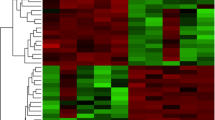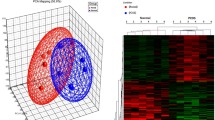Abstract
Objective
To determine the profile of differentially expressed genes in leiomyoma and matched unaffected myometrium and to identify the genes whose expression are altered after gonadotropin releasing hormone analogue (GnRHa) therapy.
Methods
Using total RNA isolated from untreated and GnRHa-treated leiomyoma and myometrium subjected to Clontech Atlas 1.2 K cancer microarray containing 1176 known genes, we found transcripts for many cytokines, growth factors and their receptors, adhesion molecules, extracellular matrix, proteases, signaling intermediates, and transcription factors in both tissues. Based on the overall normalization and reproducibility of the results, 328 differentially expressed and regulated genes with at least threefold change in their expression in untreated and GnRHa-treated tissues were chosen for further analysis.
Results
The expression value of the 328 genes subjected to significance analysis of microarray showed a total of 100 genes with relative significant change in expression. Of these genes, the expression of 18 was up-regulated and 82 down-regulated in untreated leiomyoma compared with myometrium. In GnRHa-treated tissues, the expression of 34 genes showed a significant decrease in leiomyoma, whereas 27 genes increased and 15 decreased in myometrium compared with their respective untreated tissues. There was no difference in the expressive profile of these genes when comparing leiomyoma and myometrium from the GnRHa-treated group. Hierarchical duster analysis revealed that these differentially expressed or regulated genes, classified based on their biologic functions, are involved in regulation of cell growth/cycle, signal transduction, transcription factors, and cell and tissue structure.
Conclusion
Microarray analysis allowed us to identify the profile expression of several specific genes in leiomyoma and myometrium whose expression appears to be differentially regulated after GnRHa therapy.
Similar content being viewed by others
References
Brandon DD, Bethea CL, Strawn EY. et al. Progesterone receptor messenger ribonucleic acid and protein are overexpressed in human uterine leiomyomas. Am J Obstet Gynecol 1993;169:78–85.
Brandon DD, Erickson TE, Keenan EJ, et al. Estrogen receptor gene expression in human uterine leiomyomata. J Clin Endocrinol Metab 1995;80:1876–1881.
Fujimoto J, Hirose R, Ichigo S, Sakaguchi H, Li Y, Tamaya T. Expression of progesterone receptor form A and B mRNAs in uterine leiomyoma. Tumour Biol 1998;19:126–131.
Friedman AJ. Treatment of uterine myomas with GnRH agonists. Semin Reprod Endocrinol 1993;11:154–161.
Kettel LM, Murphy AA, Morales AJ, Rivier J, Vale W, Yen SS. Rapid regression of uterine leiomyomas in response to daily administration of gonadotropin-releasing hormone antagonist. Fertil Steril 1993;60:642–646.
Takeuchi H, Kobori H, Kikuchi I, Sato Y, Mutsuhashi N. A prospective randomized study comparing endocrinological and clinicaleffects of two types of GnRH agonists in cases of uterine leiomyomas or endometriosis. J Obstet Gynaecol Res 2000;26:325–331.
Carr BR, Marshburn PB, Weatherall PT, et al. An evaluation of the effect of gonadotropin-releasing hormone analogs and medroxyprogesterone acetate on uterine leiomyomata volume by magnetic resonance imaging: A prospective, randomized, double blind, placebo-controlled, crossover trial. J Clin Endocrinol Metab 1993;76:1217–1223.
Chegini N, Rong H, Dou Q, Kipersztok S, Williams RS. Gonadotropin releasing hormone (GnRH) and GnRH receptor gene expression in human myometrial and leiomyomta and the direct action of GnRH analogs on myometrial smooth muscle cells interaction with ovarian steroids in vitro. J Clin Endocrinol Metab 1996;81:3215–3221.
Chegini N. Implication of growth factor and cytokine networks in leiomyomas. In: Hill J, ed. Cytokines in human reproduction. New Jersey: Wiley, 2000:133–162.
Ma C, Chegini N. Matrix metalloproteinases and tissue inhibitor of MMPs (TIMPs): Expression in human myometrial smooth muscle cell and regulation by transforming growth factor β1. Mol Hum Reprod 1999;5:950–954.
Chegini N, Tang XM, Ma C. Regulation of transforming growth factor-β1 expression by granulocyte macrophage-colony-stimulating factor in leiomyoma and myometrial smooth muscle cells. J Clin Endocrinol Metab 1999;84:4138–4143.
Wu X, Blanck A, Olovsson M, Moller B, Lindblom B. Expression of basic fibroblast growth factor (bFGF), FGF receptor 1 and FGF receptor 2 in uterine leiomyomas and myometrium during the menstrual cycle, after menopause and GnRHa treatment. Acta Obstet Gynecol Scand 2001;80:497–504.
Senturk LM, Sozen I, Gutierrez L, Arici A. Interleukin 8 production and interleukin 8 receptor expression in human myometrium and leiomyoma. Am J Obstet Gynecol 2001;184:559–566.
Sozen I, Olive DL, Arici A. Expression and hormonal regulation of monocyte chemotactic protein-1 in myometrium and leiomyomata. Fertil Steril 1998;69:1095–1102.
Kamada Y, Nakatsuka M, Asagiri K, et al. GnRH agonist-suppressed exprewssion of nitric oxide synthesis and generation of peroxynitrite in adenomyosis. Hum Reprod 2000;15:2512–2519.
Gustavsson I, Englund K, Faxen M, Sjoblom P, Lindblom B, Blanck A. Tissue differences but limited sex steroid responsiveness of c-fos and c-jun in human fibroids and myometrium. Mol Hum Reprod 2000;6:55–59.
Barbarisi A, Petillo O, Di Lieto A, et al. 17-Beta estradiol elicits an autocrine leiomyoma cell proliferation: Evidence for a stimulation of protein kinase-dependent pathway. J Cell Physiol 2001;186:414–424.
Mizutani T, Sugihara A, Nakamuro K, Terada N. Suppression of cell proliferation and induction of apoptosis in uterine leiomyoma by gonadotropin-releasing hormone agonist (leuprolide acetate). J Clin Endocrinol Metab 1998;83:1253–1255.
Chegini N, Kornberg L. Gonadotropin releasing hormone analogues (GnRHa) Therapy alters signal transduction pathways involving MAP and focal adhesion kinases in leiomyoma. J Soc Gynecol Invest 2003;10:21–26.
Nowak RA. Fibroids: Pathophysiology and current medical treatment. Baillieres Best Pract Res Clin Obstet Gynaecol 1999;13:223–238.
Li X, Gu W, Mohan S, Baylink DJ. DNA microarrays: Their use and misuse. Microcirculation 2002;9:13–22.
Skacel M, Skilton B, Pettay JD, Tubbs RR. Tissue microarrays: A powerful tool for high-throughput analysis of clinical specimens: A review of the method with validation data. Appl Immunohistochem Mol Morphol 2002;10:1–6.
Varela JC, Goldstein MH, Baker HV, Schultz GS. Microarray analysis of gene exprewssion patterns during healing of rat corneas after excimer laser photorefractive keratectomy. Invest Ophthalmol Vis Sci 2002;43:1772–1782.
Eisen MB, Spellman PT, Brown PO, Botstein D. Cluster analysis and display of genome-wide exprssion patterns. Proc Natl Acad Sci U S A 1998;95:14863–14868.
Tusher VG, Tibshirani R, Chu G. Significance analysis of microarrays applied to the ionizing radiation response. Proc Natl Acad Sci U S A 2001;98:10515–10515.
Dou Q, Tarnuzzer RW, Williams RS, Schultz GS, Chegini N. Differential expression of matrix metalloproteinases and their tissue inhibitors in leiomyomata: A mechanism for gonadotrophin releasing hormone agonist-induced tumour regression. Mol Hum Reprod 1997;3:1005–1014.
Arici A, Sozen I. Transforming growth factor-beta3 is expressed at high levels in leiomyoma where it stimulates fibronectin expression and cell proliferation. Fertil Steril 2000;73:1006–1011.
Lee BS, Nowak RA. Human leiomyoma smooth muscle cells show increased expression of transforming growth factor-beta 3 (TGF β3) and altered response to the antiproliferative effects of TGF β. J Clin Endocrinol Metab 2001;86:913–920.
Li S, Chiang TC, Davis GR, Williams RM, Wilson VP, McLachlan JA. Decreased expression of Wnt7a mRNA is inversely associated with the expression of estrogen receptor-alpha in human uterine leiomyoma. J Clin Endocrinol Metab 2001;86:454–457.
Fukuhara K, Kariya M, Kita M, et al. Secreted frizzled related protein 1 is overexpressed in uterine leiomyomas, associated with a high estrogenic environment and unrelated to proliferative activity. J Clin Endocrinol Metab 2002;87:1729–1736.
Kovacs KA, Oszter A, Gocze PM, Kornyei JL, Szabo I. Comparative analysis of cyclin D1 and oestrogen receptor (alpha and beta) levels in human leiomyoma and adjacent myometrium. Mol Hum Reprod 2001;7:1085–1091.
Horiuchi A, Nikaido T, Ya-Li Z, Ito K, Orii A, Fujii S. Heparin inhibits proliferation of myometrial and leiomyomal smooth muscle cells through the induction of alpha-smooth muscle actin, calponin h1 and p27. Mol Hum Reprod 1999;5:139–145.
Noguchi T, Dobashi Y, Minehara H, Itoman M, Kameya T. Involvement of cyclins in cell proliferation and their clinical implications in soft tissue smooth muscle tumors. Am J Pathol 2000;156:2135–2147.
Andersen J, Grine E, Eng CL, et al. Expression of connexin-43 in human myometrium and leiomyoma. Am J Obstet Gynecol 1993;169:1266–1276.
Lessl M, Klotzbuecher M, Schoen S, Reles A, Stockemann K, Fuhrmann U. Comparative messenger ribonucleic acid analysis of immediatew early genes and sex steroid receptors in human leiomyoma and healthy myometrium. J Clin Endocrinol Metab 1997;82:2596–2600.
Kupittayanant S, Burdyga T, Wray S. The effects of inhibiting Rho-associated kinase with Y-27632 on force and intracellular calcium in human myometrium. Pflugers Arch 2001;443:112–114.
Tsibris JCM, Segars J, Coppola D, et al. Insights from gene arrays on the development and growth regulation of uterine leiomyomata. Fertil Steril 2002;78:114–121.
Rauk PN, Surti U, Roberts JM, Michalopoulos G. Mitogenic effect of basic fibroblast growth factor and estradiol on cultured human myometrial and leiomyoma cells. J Obstet Gynecol 1995;173:571–577.
Dou Q, Zhao Y, Tarnuzzer RW, et al. Suppression of TGF-βs and TGF-β receptors mRNA and protein expression in leiomyomata in women receiving gonadotropin releasing hormone agonist therapy. J Clin Endocrinol Metab 1996;81:3222–3230.
Branton MH, Kopp JB. TGF-beta and fibrosis. Microbes Infect 1999;1:1349–1365.
Cheng KW, Leung PC. The expression, regulation and signal transduction pathways of the mammalian gonadotropin-releasing hormone receptor. Can J Physiol Pharmacol 2000;78:1029–1052.
Kraus S, Naor Z, Seger R. Intracellular signaling pathways mediated by the gonadotropin-releasing hormone (GnRH) receptor. Arch Med Res 2001;32:499–509.
Pearson G, Robinson F, Gibson TB. Mitogen-activated protein (MAP) kinase pathways: Regulation and physiological functions. Endocr Rev 2001;22:153–183.
Marais R, Wynne J, Treisman R. The SRF accessory protein Elk-1 contains a growth factor-regulated transcriptional activation domain. Cell 1993;73:381–393.
Wu X, Blanck A, Olvsson M, Henriksen R, Lindblom B. Expression of Bcl-2, Bcl-x, Mcl-1, Bax and Bak in human uterine leiomyomas and myometrium during the menstrual cycle and after menopause. J Steroid Biochem Mol Biol 2002;80:77–83.
Miller JR. The Wnts. Genome Biol 2002;3:1–15.
Saitoh T, Mine T, Katoh M. Frequent up-regulation of WNT5A mRNA in primary gastric cancer. Int J Mol Med 2002;9:515–519.
van Gijn ME, Snel F, Cleutjens JP, Smits JF, Blankesteijn WM. Overexpression of components of the Frizzled-Dishevelled cascade results in apoptotic cell death, mediated by β-catenin. Exp Cell Res 2001;265:46–53.
Li L, Yuan H, Xie W, et al. Dishevelled proteins lead to two signaling pathways. Regulation of LEF-1 and c-Jun N-terminal kinase in mammalian cells. J Biol Chem 1999;274:129–134.
Grundker C, Volker P, Emons G. Antiproliferative signaling of luteinizing hormone-releasing hormone in human endometrial and ovarian cancer cells through G protein α(I)-mediated activation of phosphotyrosine phosphatase. Endocrinology 2001;142:2369–2380.
Everest HM, Hislop JN, Harding T, et al. Signaling and antiproliferative effects mediated by GnRH receptors after expression in breast cancer cells using recombinant adenovirus. Endocrinology 2001;142:4663–4672.
Stewart EA, Rhoades AR, Nowak RA. Leuprolide acetate-treated leiomyomas retain their relative overexpression of collagen type I and collagen type III messenger ribonucleic acid. J Soc Gynecol Investig 1998;5:44–47.
Palmer SS, Haynes-Johnson D, Diehl T, Nowak RA. Increased expression of stromelysin 3 mRNA in leiomyomas (uterine fibroids) compared with myometrium. J Soc Gynecol Investig 1998;5:203–209.
Fransson LA, Belting M, Jonsson M, Mani K, Moses J, Oldberg A. Biosynthesis of decorin and glypican. Matrix Biol 2000;19:367–376.
Kresse H, Schonherr E. Proteoglycans of the extracellular matrix and growth control. J Cell Physiol 2001;189:266–274.
Author information
Authors and Affiliations
Corresponding author
Additional information
Supported by grant NIH HD37432 from the National Institutes of Health, Bethesda, Maryland.
Rights and permissions
About this article
Cite this article
Chegini, N., Verala, J., Luo, X. et al. Gene Expression Profile of Leiomyoma and Myometrium and the Effect of Gonadotropin Releasing Hormone Analogue Therapy. Reprod. Sci. 10, 161–171 (2003). https://doi.org/10.1016/S1071-5576(03)00004-2
Published:
Issue Date:
DOI: https://doi.org/10.1016/S1071-5576(03)00004-2




